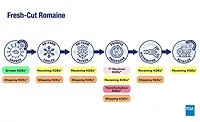TECH FLASH
FDA proposes new “action level” for arsenic in apple juice
The new regulations require the arsenic level to be no higher than that of drinking water.
As the result of a risk assessment study, FDA will institute a new “action level” for arsenic in apple juice of 10 parts per billion, the same level allowed in tap water. The agency says it has been monitoring the presence of arsenic in apple juice for the past 20 years, but new tools have allowed a more complete understanding of the levels of inorganic and organic arsenic.
Last year, FDA tested 94 samples and found total arsenic levels of 10 parts per billion or less in 95 percent of them. All samples were found to contain less than 10 parts per billion of inorganic arsenic, the carcinogenic form of the chemical.
The proposed action level takes into account this sampling’s data, plus a recently completed peer-reviewed risk assessment of arsenic in apple juice. The assessment, conducted by FDA scientists, is based on lifetime exposure.
“While the levels of arsenic in apple juice are very low, FDA is proposing an action level to help prevent public exposure to the occasional lots of apple juice with arsenic levels above those permitted in drinking water,” says Michael R. Taylor, FDA’s deputy commissioner for food and veterinary medicine.
Inorganic arsenic finds its way into foods because it is present in the environment as a naturally occuring mineral and a byproduct of the use of arsenic-containing pesticides. In addition to being a known carcinogen, inorganic arsenic is also associated with skin lesions, cardiovascular disease, developmental effects, neurotoxicity and diabetes.
FDA will accept public comments on the proposed action level and risk assessment for 60 days from July 12, when the notice was published.
Looking for a reprint of this article?
From high-res PDFs to custom plaques, order your copy today!







